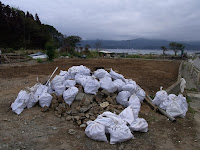From Yonesaki we followed route 45 towards Kessennuma, passing by the home of an elderly couple where I worked as a volunteer in 2011. In 2011 there was a lot of heavy debris - a lot of concrete, bitumen from the roads that were washed away and a lot of glass. Apparently many cars turned over here on as they were swept away. When we were up there before the old man was telling how he used to have a very good vegetable patch. There didn't seem to be much in the way of a vegetable patch, though there were quite a lot of sunflowers. I tossed up whether to stop and see how they were, but with the lack of an omiyage and not very much time, I hesitated to do so. Living in such a prominent spot, they probably get stickybeaks (like me) passing through regularly. I doubt this will be rezoned for housing, but they seemed to be doing OK.
 |
| 2013 August |
 |
| 2011 Sept |
 |
| 2011 Sept |
 |
| Sept 2011 |
 |
| Sept 2011 |
 |
| The famous boat of Kessennuma. There has just been a vote taken in Kessenuma and more than 60% of people want the boat removed. |








2 comments:
Random thoughts.
Dependency is insidious. I've seen it creep up and take over too often in Africa. (That in itself is a controversial, potentially insensitive thing to say. My life wasn't destroyed by a tsunami or a war.)
I would've been in the 40%, but again, I don't live there.
"Daiichi leaking poison into the ocean". As I've mentioned before, I often wonder whether the real danger isn't starting now, but nobody seems to pay much attention, and I include myself in that. Quoth the non-seafood-lover.
Yes... it's totally off the radar. There is no future for seafood industries in radioactivity contaminated water...
No fishing and oysters, no industry to sustain the towns.
I was aghast to read about Iwaki opening beaches this summer... It's totally off the radar & yet there's all this smugness with the Olympics coming up that Japan is the "safety" option.
Post a Comment